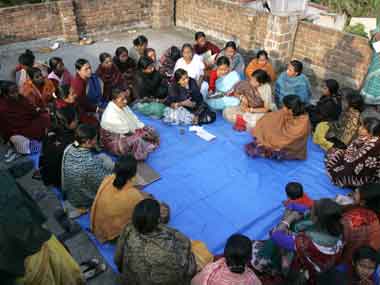The Indian microfinance industry hit a brick wall a few months ago when Andhra Pradesh decided to regulate its loan recovery processes. Last Friday, it received another shock when JP Morgan slashed the share price target of SKS Microfinance, the industry’s former poster-boy, from Rs 550 to Rs 200.
SKS’s shares crashed from Rs 411 to Rs 331.30, a drop of 20% in a single day. On Monday, the share collapsed a furhter 16 percent to Rs 271 about mid-afternoon. JP Morgan has slashed the target price on expectations of an Rs 700 crore loss due to writeoffs related to the company’s Andhra Pradesh business. Reports from the field suggest that loan recoveries are as low as 10 percent in Andhra, which accounts for Rs 1,400 crore of the company’s loan portfolio. SKS has a net worth (share capital plus reserves) of Rs 1,781 crore and cash and bank balances of Rs 558 crore. Its borrowings exceed Rs 2,700 crore. If the collection rates turn out to be as low as indicated, SKS is in serious trouble. Not only will SKS be hit, the entire sector will take a body blow.
[caption id=“attachment_6474” align=“alignleft” width=“380” caption=“Women from a medical self-help group attend a meeting. Reuters”]  [/caption]
Microfinance started out as a non-governmental initiative among self-help groups. However, looking at the growth and potential of the sector, private players smelt a bonanza. Their claimed motive was upliftment of the poor, but the moolah was mouth-watering, with interest rates being as high as 30-50 percent. By borrowing cheap and lending at usurious rates, microfinance companies gave themselves a hefty spread. Smelling big money, the field soon attracted many players, leading to a fight for marketshare. Many borrowers took multiple loans from different lenders, and lenders used strong-arm methods with those who could not replay.
Andhra Pradesh was their experimental laboratory. Reports suggest that 82% of the poor population in the state borrowed from one source or the other compared to an average of 20% in other states. With such high levels of indebtedness, it was only logical to expect political interference. It came last year.
Being unsecured, microfinance loans (usually not exceeding Rs 50,000) are always difficult to recover. Companies in the sector measured their efficiencies by their recovery rates. A microfinance company with high rates of recovery was thus more likely to succeed than one with a lower recovery rate. Recovery departments thus had tough men to ensure higher rates, with their salaries pegged to rates. This resulted in unconventional means of recovery, which in some cases resulted in suicide.
Impact Shorts
More ShortsA microfinance company generally lends small amounts for purposes like buying sheep or cows or even opening roadside tea-stalls. In case the cow died, and the borrower was unable to repay, the company would finance another animal, but expect the client to pay for both. This ensured that loans seldom went bad, but imposed a higher burden on borrowers. Using a single asset to repay two loans was clearly a recipe for disaster. In the past, this was how moneylenders enslaved borrowers as bonded labour when they couldn’t repay.
In Andhra, high loan growth created cut-throat competition for business, and microfinance companies started lending for consumption rather than income-earning assets. This resulted in the same borrower having multiple loans. Cases have been reported where construction labourers earning barely Rs 2,000 a month raised loans worth over Rs 2 lakh. At 30 percent, this meant paying an interest of Rs 5,000 a month! There was no way to repay without raising another loan. In a report by Avendus India Equity Research, it has been pointed out that there is a positive correlation between the number of microfinance institutions (MFIs) and the level of defaults. In places where there was only one player, the level of defaults was 34% (still high by banking standards); where there were six players, defaults more than doubled to 78%.
Compare this with the performance of NGOs like Friends of Women’s World Banking (FWWB), which has a repayment rate as high as 99% with a portfolio at risk (as of 30 days) of 0.95%.
This is not the first time in India that companies like SKS have been affected by political interference, or a ‘ganging-up’ of defaulters. The same report of Avendus states that in 2006, the local administration of Krishna district closed 50 branches of four MFIs following unethical collections and illegal operational practices. In Kolar in 2009, mass defaults, prompted by credible orders from local Muslim organisations which forbade Muslims from continuing to borrow from MFIs, resulted in defaults in the range of 25%-80%. In 2010, the Andhra government, in response to the outcry over coercive recovery practices, implemented a highly restrictive ordinance to curb the practice. The extent of MFI losses is still unknown, but with recoveries falling to 10%, according to JP Morgan, this loss can be bigger than Kolar.
The industry is in a mess as many microfinance companies had a higher portion of their income coming from Andhra. In the case of SKS, write-offs to the extent mentioned by JP Morgan could destroy the balance-sheet completely.
Hypercompetition has put paid to the high hopes invested in microfinance. It is time to rethink the economics of the sector and improve regulation.


)

)
)
)
)
)
)
)
)



